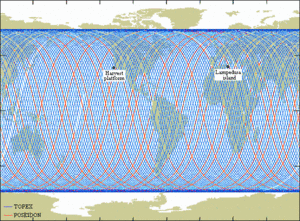Evaluating the Topex/Poseidon system
Patrick Vincent, Yves Ménard (Cnes, France)
After six months in orbit, the Topex/Poseidon satellite has accumulated a lot of data, and 10 merged Interim Geophysical Data Record (IGDR) cycles have been made available for the project and scientific community for validation.
The main problems regarding the engineering assessment have been resolved. The most critical was mispointing which has been corrected since cycle 9 and now reached the pre-launch expected performance. The December 10, 1992 and January 11, 1993 maneuvers to calibrate the attitude show a great improvement on the bus attitude control. Since cycle 9, the mispointing error has been well below 0.2°. The impact on the altimetric measurement noise level is thus greatly reduced.
An enhanced algorithm has been designed to refine the mispointing correction on earlier cycles.
The first results of on-site calibration are encouraging and are in accordance with the statistical results at crossover points. However the error bars are still large. Processing more overflights and re-analyzing the altimetric data should improve the preliminary results.
The intensive Lampedusa calibration experiment terminated on December 10, 1992, when the Institut für angewandte Geodäsie (IfaG) laser station was removed. However, a minimum instrument set has been maintained on the site including three tide gauges, the Doris beacon and the WVR JPL radiometer.
From cycle 1 to December 10 there were eight flights over Lampione plus two passes before cycle 1, on September 11 (located 20 km west of Lampedusa as the orbit was not yet adjusted) and September 21. Detailed information about the data collection status can be found in the Topex/Poseidon Calval bulletins provided by the Topex/Poseidon project team. When possible, the closure equation was run with different estimations of the radial orbit component over Lampione. These solutions were derived either from the laser short arc orbit produced by Cerga/GRGS, or by 1-day GPS solutions produced by B.J. Haines (JPL visiting scientist at Cnes/GRGS). The global 10-day arc Doris solutions produced by the Doris Orbitography Group at Cnes were used.
The Poseidon bias seems to be close to 4 cm. For Topex, only one bias was computed for cycle 4 at Cnes/GRGS, with the laser short arc orbit. The value is -20 cm which is consistent with the results obtained at the NASA calibration site (Harvest platform). The difference between the Poseidon and Topex altimeter biases-Topex is apparently measuring shorter than Poseidon-has been confirmed by statistical analysis at the crossover points.
The environmental corrections (ionosphere, troposphere) were carefully evaluated using statistics and regional and global comparisons (see article by Jacques Stum). The Doris and Topex ionosphere corrections have been improved and the difference between them is now below 2 cm rms. The TMR and the ECMWF wet troposphere corrections are apparently biased by about 1.5 cm. For the sea-state bias, more study is needed, especially for Poseidon because more data is required to better adjust the algorithm coefficients.

Estimation of Poseidon bias (  short arc,
short arc,  precise orbit solution,
precise orbit solution,  GPS) and formal estimation error.
GPS) and formal estimation error.
The wind speed and wave-height measured by the Topex and Poseidon altimeters were validated by comparing with Météo France weather models. The results point to apparent wind speed bias, which suggests an adjustment of the sigma naughts. However, new analysis over a larger data set is going on to confirm these results. A new wind speed algorithm based on sigma-naughts and wave-height is also being investigated.
For more detailed results, please contact the Topex/Poseidon Calval team. Most of the results are already in the JVT meeting minutes (Pasadena, February 22-25, 1993), and will be used by the ground segments to begin GDR data production in July 1993.





